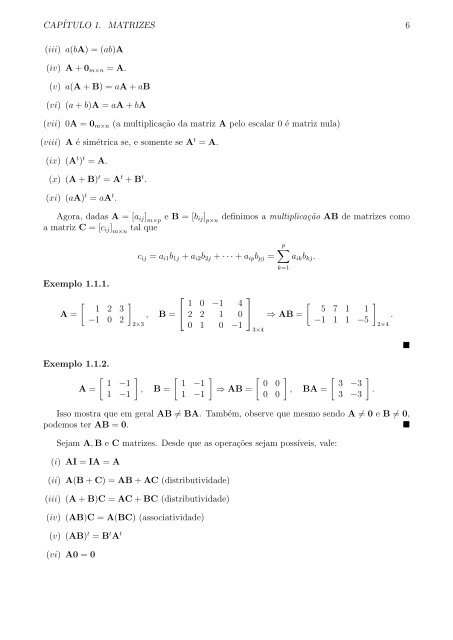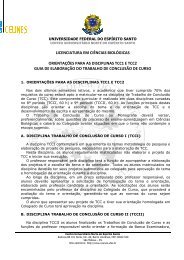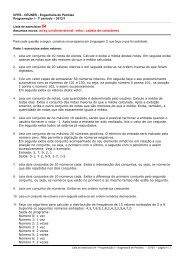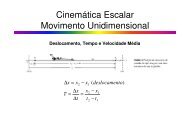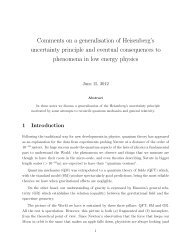- Page 1 and 2: Programação Linear - Notas de aul
- Page 3 and 4: SUMÁRIO 26 Elementos de Análise C
- Page 5: Parte IRevisão4
- Page 9 and 10: CAPÍTULO 1. MATRIZES 81.4 Exercíc
- Page 11 and 12: Capítulo 2Sistemas LinearesUma equ
- Page 13 and 14: CAPÍTULO 2. SISTEMAS LINEARES 12O
- Page 15 and 16: CAPÍTULO 2. SISTEMAS LINEARES 14Ag
- Page 17 and 18: CAPÍTULO 2. SISTEMAS LINEARES 16
- Page 19 and 20: Capítulo 3DeterminantesDada uma ma
- Page 21 and 22: CAPÍTULO 3. DETERMINANTES 203.1 De
- Page 23 and 24: CAPÍTULO 3. DETERMINANTES 223.3 Ex
- Page 25 and 26: Capítulo 4Espaços VetoriaisDefini
- Page 27 and 28: CAPÍTULO 4. ESPAÇOS VETORIAIS 26E
- Page 29 and 30: CAPÍTULO 4. ESPAÇOS VETORIAIS 28O
- Page 31 and 32: CAPÍTULO 4. ESPAÇOS VETORIAIS 301
- Page 33 and 34: CAPÍTULO 4. ESPAÇOS VETORIAIS 32(
- Page 35 and 36: Capítulo 5IntroduçãoProblemas de
- Page 37 and 38: CAPÍTULO 5. INTRODUÇÃO 36Por out
- Page 39 and 40: CAPÍTULO 5. INTRODUÇÃO 385.2 Exe
- Page 41 and 42: CAPÍTULO 5. INTRODUÇÃO 40Tipo de
- Page 43 and 44: CAPÍTULO 5. INTRODUÇÃO 425.3 Res
- Page 45 and 46: CAPÍTULO 5. INTRODUÇÃO 44Figura
- Page 47 and 48: CAPÍTULO 6. ELEMENTOS DE ANÁLISE
- Page 49 and 50: CAPÍTULO 6. ELEMENTOS DE ANÁLISE
- Page 51 and 52: CAPÍTULO 6. ELEMENTOS DE ANÁLISE
- Page 53 and 54: CAPÍTULO 6. ELEMENTOS DE ANÁLISE
- Page 55 and 56: CAPÍTULO 7. O MÉTODO SIMPLEX 54At
- Page 57 and 58:
CAPÍTULO 7. O MÉTODO SIMPLEX 56Ex
- Page 59 and 60:
CAPÍTULO 7. O MÉTODO SIMPLEX 587.
- Page 61 and 62:
CAPÍTULO 7. O MÉTODO SIMPLEX 60Co
- Page 63 and 64:
CAPÍTULO 7. O MÉTODO SIMPLEX 62e
- Page 65 and 66:
CAPÍTULO 7. O MÉTODO SIMPLEX 647.
- Page 67 and 68:
CAPÍTULO 7. O MÉTODO SIMPLEX 66z
- Page 69 and 70:
CAPÍTULO 7. O MÉTODO SIMPLEX 68Ex
- Page 71 and 72:
CAPÍTULO 7. O MÉTODO SIMPLEX 707.
- Page 73 and 74:
CAPÍTULO 7. O MÉTODO SIMPLEX 72==
- Page 75 and 76:
CAPÍTULO 7. O MÉTODO SIMPLEX 74}{
- Page 77 and 78:
CAPÍTULO 7. O MÉTODO SIMPLEX 76p
- Page 79 and 80:
Capítulo 8Método Simplex: inicial
- Page 81 and 82:
CAPÍTULO 8. MÉTODO SIMPLEX: INICI
- Page 83 and 84:
CAPÍTULO 8. MÉTODO SIMPLEX: INICI
- Page 85 and 86:
CAPÍTULO 8. MÉTODO SIMPLEX: INICI
- Page 87 and 88:
CAPÍTULO 8. MÉTODO SIMPLEX: INICI
- Page 89 and 90:
CAPÍTULO 8. MÉTODO SIMPLEX: INICI
- Page 91 and 92:
CAPÍTULO 8. MÉTODO SIMPLEX: INICI
- Page 93 and 94:
Capítulo 9O Simplex RevisadoDada u
- Page 95 and 96:
CAPÍTULO 9. O SIMPLEX REVISADO 94(
- Page 97 and 98:
CAPÍTULO 9. O SIMPLEX REVISADO 96
- Page 99 and 100:
Capítulo 10DualidadePara um dado P
- Page 101 and 102:
CAPÍTULO 10. DUALIDADE 100Como sab
- Page 103 and 104:
CAPÍTULO 10. DUALIDADE 102Demonstr
- Page 105 and 106:
CAPÍTULO 10. DUALIDADE 104Demonstr
- Page 107 and 108:
CAPÍTULO 10. DUALIDADE 106Figura 1
- Page 109 and 110:
CAPÍTULO 10. DUALIDADE 108Como já
- Page 111 and 112:
CAPÍTULO 10. DUALIDADE 110Observam
- Page 113 and 114:
CAPÍTULO 11. ANÁLISE DE SENSIBILI
- Page 115 and 116:
CAPÍTULO 11. ANÁLISE DE SENSIBILI
- Page 117 and 118:
CAPÍTULO 11. ANÁLISE DE SENSIBILI
- Page 119 and 120:
CAPÍTULO 11. ANÁLISE DE SENSIBILI
- Page 121 and 122:
CAPÍTULO 11. ANÁLISE DE SENSIBILI
- Page 123 and 124:
CAPÍTULO 11. ANÁLISE DE SENSIBILI
- Page 125 and 126:
CAPÍTULO 11. ANÁLISE DE SENSIBILI
- Page 127 and 128:
CAPÍTULO 11. ANÁLISE DE SENSIBILI
- Page 129 and 130:
Capítulo 12O Problema do Transport
- Page 131 and 132:
CAPÍTULO 12. O PROBLEMA DO TRANSPO
- Page 133 and 134:
CAPÍTULO 12. O PROBLEMA DO TRANSPO
- Page 135 and 136:
CAPÍTULO 12. O PROBLEMA DO TRANSPO
- Page 137 and 138:
CAPÍTULO 12. O PROBLEMA DO TRANSPO
- Page 139 and 140:
CAPÍTULO 12. O PROBLEMA DO TRANSPO
- Page 141:
Referências Bibliográficas[1] Mok


